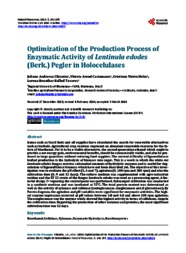Optimization of the production process of enzymatic activity of Lentinula edodes (Berk.) Pegler in holocelulases.
Optimization of the production process of enzymatic activity of Lentinula edodes (Berk.) Pegler in holocelulases.
Author(s): CHICATTO, J. A.; CASTAMANN, V. A.; HELM, C. V.; TAVARES, L. B. B.
Summary: Issues such as fossil fuels and oil supplies have stimulated the search for renewable alternatives such as biofuels. Agricultural crop residues represent an abundant renewable resource for the future of bioethanol. For it to be a viable alternative, the second-generation ethanol which ought to provide a net energy gain, environmental benefits, should be economically viable, and also be produced in large quantities without reducing food supplies. The current difficulty of lignocellulosic biofuel production is the hydrolysis of biomass into sugar. This is a work in which the white-rot Lentinula edodes fungus secretes substantial amounts of hydrolytic enzymes and is useful for degradation of lignocellulosic biomass which have not been described yet. The objective of this investigation was to evaluate the pH effect (5, 6 and 7), agitation (0, 100 rpm and 200 rpm) and also the cultivation time (6, 9 and 12 days). The culture medium was supplemented with agro-industrial residue and the EF 52 strain of the fungus Lentinula edodes was used as a processing agent. A factorial design 22 repeating the central point was performed. Submerged cultivation was conducted in a synthetic medium and was incubated at 25?C. The total protein content was determined as well as the activity of xylanase and cellulase (endoglucanase, exoglucanase and ?-glucosidase). By Pareto diagram, the agitation and pH variables were significant for enzymatic activities. The highest enzyme expression occurred at pH values between 5.0 and 6.0 and above 100 rpm agitation. The exoglucanase was the enzyme which showed the highest activity in terms of cellulases, despite the cultivation time. Regarding the production of other enzymes and proteins, the most significant cultivation time was 12 days.
Publication year: 2014
Types of publication: Journal article
Unit: Embrapa Forestry
Observation
Some of Embrapa's publications are published as ePub files. To read them, use or download one of the following free software options to your computer or mobile device. Android: Google Play Books; IOS: iBooks; Windows and Linux: Calibre.
Access other publications
Access the Agricultural Research Database (BDPA) to consult Embrapa's full library collection and records.
Visit Embrapa Bookstore to purchase books and other publications sold by Embrapa.

